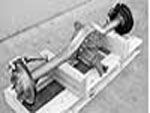
It can be hard to purchase parts that don’t offer some sort of aesthetic appeal or an obvious increase in power.
Take the fuel system, for example. A trick fuel pump doesn’t really make power, it simply allows you to support the power your engine is capable of producing safely and reliably. The same principal applies to a rearend. Sure, 99 percent of us wouldn’t hesitate to toss in a set of steeper gears or a posi. But what about supplying the third member with the rest of the equipment to withstand the torque you’re going to throw at it? Some may question if it’s even necessary to beef up the rear at all—especially if they’ve never witnessed the carnage resulting from an exploded rearend. But how do you know when enough is enough?
Not everyone needs a spool or tree-trunk sized axles in their 14-second bracket racer. Also, how do you know when a modified stock rearend is sufficient, or if you should just go ahead and upgrade to an aftermarket unit? Much of the decision is contingent on how you use the car. Do you drag race, road race, desire a wider selection of gear ratios, or just want better brakes for your street machine? In the case of our ’65 Biscayne, we wanted everything, and brutal strength was a must. After discussing our needs with Currie Enterprises, we decided to build a Currie 9-Plus housing complete from brake to brake. If you’re not familiar with the 9-Plus series, we’ll just tell you it’s everything Ford originally designed the 9-inch to be, only better.